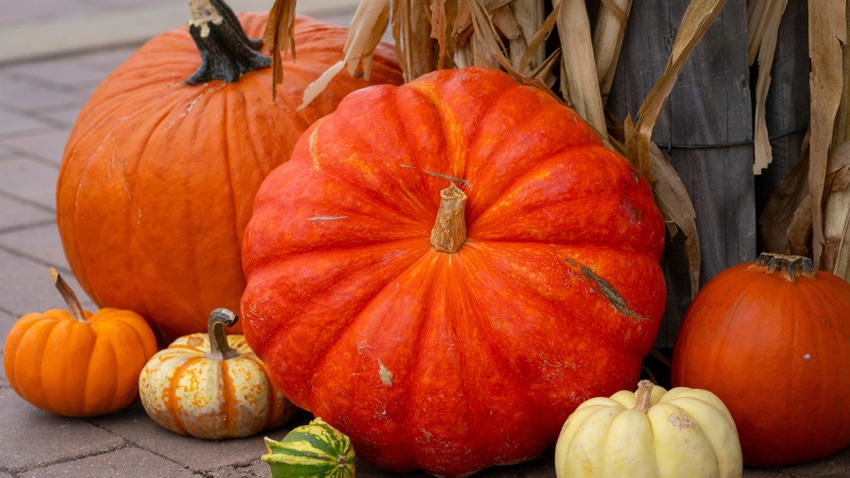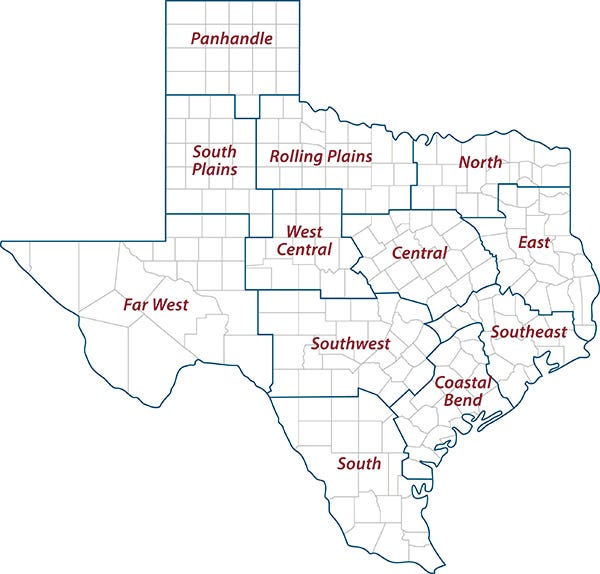
Texas pumpkin producers experienced another season of yields well below average, according to a Texas A&M AgriLife Extension Service expert.
Mark Carroll, AgriLife Extension agriculture and natural resources agent for Floyd County, said this year’s pumpkin production yields are down 20%-40% due to drought in areas where the bulk of Texas’ crop is grown.
Pumpkin production
Producers in Floyd County, also known as the Pumpkin Capital of Texas, have started to wrap up the pumpkin harvest. Pumpkins were planted in early June, and they quickly noticed drought created tough growing conditions that contributed to extremely low yields for most varieties.
“This year’s production has been a mixed bag,” said Danny Nut, owner of DL Nut Farms in Floyd County. “Some varieties have produced their usual amount, but others were extremely low in quantity.”
Pumpkins usually do well in dry conditions if they can keep moisture in the soil around them through timely rainfall or irrigation systems. This year’s crop went six weeks without rain after mid-July, which was detrimental to production.
“DL Farms usually keeps drip irrigation over the pumpkins,” Nut said. “But this year, we decided to keep our crop irrigated with a pivot to try and keep up. It just couldn’t keep up.”
Irrigation systems could not compete with heat-related evaporation and meet plant moisture demand, which led to more pumpkins in the field that were not harvestable.
Pumpkin market
While producers are dealing with production yields being down 20%-40%, they also must deal with the loss of pumpkins during shipping to wholesale markets.
Pumpkins produced in Floyd County are shipped across the state and nation, and producers are reporting increased fruit losses due to the extreme heat, which causes pumpkins to degrade in the trailers before they reach their destination.
“Producers have to replace the pumpkins that were lost once they arrive at the destination,” Carroll said.
With continued high demand, the low yields and heat-related shipping spoilage are likely to mean higher pumpkin prices compared to last year.
“Consumers should buy pumpkins as soon as they see them,” Carroll said.
AgriLife Extension district reporters compiled the following summaries:

CENTRAL
The district experienced cooler weather with increased humidity. Some scattered storms earlier in the week damaged crops. Despite the recent moisture and cool front, the district remained plagued by persistent drought and above-average temperatures. Stock tanks were low, and creeks were holding stagnant puddles. Approximately 50% of the expected small grain fields had been planted and germinated. The cotton harvest was challenging due to the drought impacting yields and fiber quality. Pecan orchards were plagued by aphids, necessitating spraying due to their high numbers. The Pawnee pecan variety was expected to be ready for harvest soon with poor to fair yields and quality expected. Rangeland conditions improved slightly with greener pastures and hayfields reported as well, though additional rain was needed. In some counties, conditions improved enough for producers to consider another round of hay. Cattle remained in good condition, and supplemental feeding continued with a slight downturn.
ROLLING PLAINS
Some scattered showers fell over the district with cooler temperatures. Many farmers started sowing wheat. With the forecast calling for cooler temperatures and possibly more rain, producers were hoping wheat would get off to a good start. More was needed to replenish livestock drinking sources and improve rangeland conditions and soil moisture content going into the fall and winter.
COASTAL BEND
Most areas received scattered rainfall, but topsoil moisture was still lacking overall. More rain was in the forecast. Fall bedding work was ongoing in crop fields. Timely rain could improve pasture conditions and provide the chance for one last hay cutting for the season. Most livestock found enough green forage to maintain their body condition, but many producers supplemented their diets with hay and protein. Culling cows continued at a higher rate than average, and calves were shipped at lighter weights than usual. Auction market prices remained high. Many livestock producers were trying to hold on due to concerns about replacement costs and expected high calf prices in the future. Low stock pond water levels continued to cause concern for producers and were being monitored.
EAST
Recent rainfall helped areas of the district bounce back. Ponds and creeks rose to more normal levels. Some counties were able to lift their burn bans as well. Pasture and rangeland conditions were still very poor to fair. Topsoil conditions were short to adequate, and subsoil conditions were short. Producers in some areas, like Anderson and Panola counties, reported another cutting of hay, and producers in other counties remained hopeful for a final cutting. But recent forage growth also brought the problem of widespread armyworm infestations. Livestock were doing fair to good with some supplemental feeding taking place.
SOUTH PLAINS
Dry conditions continued throughout the district. Farmers were preparing for the cotton harvest. Many were making plans to apply harvest aids in the coming days and weeks. Most corn fields were cut, and sorghum was being harvested as it matured. The pumpkin crop was finishing up. Pumpkin yields this year were down 30%-40% due to the extreme heat this summer. Silage was being cut at a rapid pace. Cattle were in good condition and were still utilizing improved pastures from the July rains.
PANHANDLE
Hot and dry conditions continued across the district. Above-average temperatures and little to no rainfall caused many crops to struggle through the last part of the summer into the fall. The small amount of rain received the previous month did not last long. Most of the corn harvested was going to silage instead of grain. Producers began to defoliate cotton; irrigated acres were in good condition. Dryland cotton that survived was harvested. Pastures and rangelands were in fair condition but needed moisture. Rangelands continued to dry down and go dormant. Livestock were in good condition as ranchers fed hay and supplements daily. Hay supplies were replenished due to timely rains throughout the growing season.
NORTH
The district was very dry as temperatures continued to stay high. Topsoil moisture levels ranged from short to adequate. No wheat or oats were planted. All crops except cotton were harvested. Livestock conditions were fair to good. Pasture conditions improved in some counties, and pastures were still poor to fair due to drought.
FAR WEST
Daytime temperatures were in the upper 80s to mid-90s, with overnight temperatures in the upper 60s to mid-70s. Rain varied in the region, anywhere from trace amounts to upwards of 1 inch. Soil moisture levels remained adequate to good. Cotton defoliation picked up as growers prepared for harvest. Most cotton fields failed due to drought and extreme heat and were shredded and plowed under. Lower grain sorghum yields were expected. Hay grazer and sunflowers headed out. Corn was harvested. Wheat planting slowed as most growers were waiting for some moisture before going much further. Pecan pods were cracking open, and harvesting should begin in three weeks. Livestock were in fair condition, and producers continued supplementing with hay and grain. More producers were taking livestock to the sale.
WEST CENTRAL
Recent rains improved conditions; however, much more was needed to grow grass before winter. Warm conditions allowed producers to prepare fields for oat and wheat planting, with a few beginning to sow. Trees continued to show severe drought stress. Some hay fields were being cut and baled. Aphid and armyworm pressure increased. Stock tank levels continued to decrease. Cattle looked good and supplemental feeding continued due to the lack of grass. The cattle market decreased slightly, but producers continued selling calves to reduce pressure on cows going into winter.
SOUTHEAST
Scattered showers fell over the district, ranging from 0.5-1.5 inches, but most of the district was still extremely dry. Rice harvest was completed, pastures were being mowed, and planting ryegrass for the winter started. Producers were tilling fields and planting winter forages for over-wintering livestock. Hay was fed to livestock and becoming harder to find in the area. Producers continued to cull cattle from their herds, but the number of cattle going to market dropped slightly.
SOUTHWEST
Hot, dry conditions persisted with isolated showers providing minimal relief. The reported average rainfall for the week was a half inch, with more chances of rain in the forecast. Many gardeners gave up on planting for the year. Cotton harvest was underway, and winter wheat emerged despite challenging growing conditions. Producers continued to sell livestock, and markets were holding steady. The supplementing livestock continued due to the lack of sufficient forage on rangelands. The ongoing dry conditions were taking a toll on vegetation, with trees and brush turning brown and grass essentially nonexistent. Diet supplementation was critical as sheep and goat breeding season began.
SOUTH
Most of the district remained in moderate drought conditions after scattered rain showers delivered anywhere from 0.5-2 inches. Pastures were greening up, and temperatures remained in the mid- to upper-90s. Feed prices were high as ranchers and deer breeders supplemented livestock and wildlife. Many ranchers purchased hay they could find in preparation for the winter months. Quail populations looked healthy, and dove hunters were experiencing good hunts. Deer were plentiful, and many fawns were seen.
Read more about:
PumpkinsAbout the Author(s)
You May Also Like




